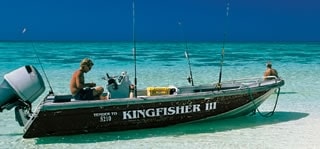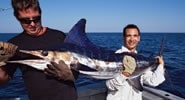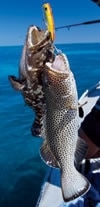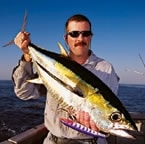
| Anglers can fish the shoals with light tackle from “tinnies,” as Australians call small, aluminum boats. |
At first sight, the Rowley Shoals were far from impressive, just a slight color change hidden behind a line of breakers. But as the Kingfisher III pulled into the lee shore, away from the swells, we were exposed to a magical sight. Protected from the open ocean by a barrier of coral, the tranquil waters of the lagoon were alive with multicolored coral brommies. Vivid blue channels divided the coral outcroppings, creating a surreal environment.
Just beyond the shallow reef, the bottom plunged hundreds of feet, forming an almost vertical wall. The Indian Ocean boiled against this natural barrier, creating massive upwellings and an ideal environment for a host of pelagic predators. With this in mind, we hurriedly set a spread of lures and teasers.

While the Rowley Shoals are known for great sailfishing, the author’s trip produced this striped marlin, the first on record for the area.|
It took less than ten minutes for the welcoming committee to arrive. A pod of sailfish appeared from nowhere and homed in on the teasers like a pack of hungry wolves. Instantly, the deck turned to bedlam as ten anglers frantically tried to drop a bait back to the hungry mob.
Eighteen hours of travel had left us completely unprepared, and we did a spectacular job of dropping every fish. However, there was no time to contemplate our failure, because moments later another pod of sails attacked. This time we were ready, and quickly scored a double hook-up – what a way to start our Rowley Shoals adventure!
The sails fought hard, but were no match for the 30-pound outfits, and after 15 minutes they were brought alongside and released. Hoping for more billfish, we quickly reset the spread. However, instead of sails we got tuna. One rod doubled over, then another and another. In seconds, all six reels were buzzing as the football-sized yellowfins charged off. As luck would have it, we went six for six. That set the precedent for the rest of the day, and we were kept busy with a steady string of yellowfins, plus the occasional wahoo to spice things up.

Rowley reef dwellers like these coral trout are so ravenous that it’s possible to catch two fish on the same plug.|
Night Moves
As the sun sank into the Indian Ocean that evening, turning the sky a beautiful orange, we anchored tight against the reef. One of the real beauties of a live-aboard charter is that you can fish 24 hours a day, and, as we quickly discovered, night fishing at the shoals is nothing short of awesome.
Baited hooks and bucktail jigs were eagerly sent to the bottom. Seconds later, rods started loading up as we found ourselves struggling with unseen denizens of the deep. To our horror, everyone wound in slack lines. Not one fish was landed!
Most of the team retired at this stage, responding to the call for dinner. However, food was the last thing on my mind, as I was curious to find out who the tackle-stealing culprits were. After upgrading my gear, I lowered a fresh bait to the bottom and immediately met with serious trouble. The rod doubled over and I found myself straining to stop a fish that was hell bent on reaching the coral. Even with the drag cranked down and my thumb on the spool, my adversary managed to take line. Somehow the rod didn’t explode, and I was able to turn the fish’s head. Five minutes later, a big, mean red bass, which looks similar to a cubera snapper, was thrashing on the surface.
As the night wore on, the variety of fish kept growing to include various species of emperor, trevally and even some dogtooth tuna. After a few hours of this amazing action, we finally retired to our bunks in order to rest up for the next day’s activities.
The following morning we were up at dawn and trolling while breakfast was served. The 57-foot Kingfisher III has a massive back deck, and is laid out in such a way that the dining table has a perfect view of the stern. As a result, we were able to enjoy a cooked breakfast while watching the rods. Now that’s what I call luxury fishing!

Glenn MacCarthy enticed this pretty bluefin trevally to hit his popping plug.|
Unfortunately, the day proved very quiet, and by midday we had only accounted for a couple of wahoo and barracuda, so we decided to pack up and head over to Clerke Reef, some four hours away. The decision to move was a good one, and we found a lot more action in the form of tuna and sails, which kept us entertained for the rest of the day.
Once again, things really started to liven up after dark. Bigeye and black trevally swarmed around the boat, snapping at baitfish attracted by the lights, while larger shapes cruised the depths. Casting poppers and flies elicited some mind-blowing surface strikes.
Later in the night we rigged up some larger baits and drifted them into the darkness. The first customer was a dogtooth tuna in the 40-pound range, quickly followed by a large “Spanish mackerel,” Australia’s answer to the king mackerel. Our final hook-up for the night turned out to be one of the best – a massive dogtooth in the 100-pound class that fought for a good half hour before finally being subdued.
Inside the Reef
The following morning we planned to take advantage of the high tide and fish inside the atoll. After slipping through one of the narrow channels, we dropped some of the team on a small sand island to explore the flats, then powered off across the lagoon.

Sailfish provide plenty of action at the shoals in July – upwards of 60 fish have been caught in a single day.|
The shoals are famous for their inshore fishing, and the topwater action can be spectacular. Being a popper-fishing fanatic, I was champing at the bit to see whether or not the lagoon fishery would live up to its reputation. I was not disappointed.
On my first cast, two brown shapes rushed out of the depths and repeatedly attacked my popper. If I had had any hooks on it I might have even caught one! While the rest of the crew struggled with hordes of bad-tempered coral trout (very similar to grouper) that continuously buried them in the reef, I had a ball trying to land one on my hookless popper. There were that many fish! Changing tactics, I switched to a big pencil popper (with hooks) and cast it straight down the throat of a bluefin trevally.
We continued fishing for three hours, and I don’t think we had more than a handful of casts that didn’t draw the attention of a trout, trevally, grouper or barracuda. On a number of occasions we even caught multiple fish on a single lure, one on each treble hook!

MacCarthy shows off a wahoo that sped into range while other fish were feeding.|
The only problem with fishing the lagoon is the time limitation. If you don’t keep an eye on the tide you can easily end up stranded. So with the water quickly dropping we met up with the other boat and made for deeper water.
Trolling the Wall
Back on the Kingfisher III, we went for a refreshing swim, then headed around to the far side of the atoll for a bit of bluewater trolling. The current was really pumping, causing the water to boil and swirl as it collided with the drop-off.
Almost immediately we had a strike, but failed to hook up. Ten minutes later we opened our account with a wahoo in the 50-pound range. This was the start of an exciting wahoo bite. More often than not we had multiple strikes from these oceanic speedsters, which tore across the surface with the line rooster-tailing behind. We also encountered more sails, black marlin, yellowfins and even rainbow runners. The session only ended when the sun finally disappeared.
Day four started off with a small striped marlin, which was not only a first for the angler, but the first for northwestern Australia. Ironically, the fisherman in question had come to the Rowley Shoals to catch a sailfish, but went home with a marlin instead!
With the tides suitable that afternoon, we piled back into the tinnies (Australian for small aluminum boats) for another assault on the lagoon. Although the fishing was not quite as hot as the previous day, we had our arms stretched by a multitude of fish.

Sporty yellowfin tuna feed in packs around the shoals, and often attack plugs with abandon.|
One Last Fish
On our final day we trolled the reef edges in the tinnies and got completely blown away by just about everything we hooked. It didn’t seem to matter what we did – the fish would always drill us into the reef. It happened so often that we became quite blas¿ about losing lures. However, we did manage to regain some stature by beating a few trevally and some big emperor before returning to the mothership.
By this time it was midday and, with just an hour to spare before the long journey back to Broome, we decided to anchor up and enjoy a leisurely lunch and a spot of bottom fishing. Dropping a bait to the bottom, I had barely closed the bail before I started losing line. Then nothing – the fish was gone. A few seconds later, one of the other anglers hooked up and, after winning a bit of line, suddenly hit a brick wall. Expecting another bust-off, we were all surprised when he started gaining line again. A few minutes later, a massive coral trout was hoisted aboard. In its mouth was the hook, as well as the smaller trout that had first eaten it!
As our excursion proved, the Rowley Shoals is a unique destination that, thanks to its isolation, sees little sport fishing pressure and no commercial fishing at all. Heading home that afternoon, I reflected back on a trip that could only be described as phenomenal. Where else in the world could you get so many fishing options crammed into one trip.
| ### Show Me to the Shoals |

The Rowley Shoals are made up of three individual atolls – Imperieuse, Clerke and Mermaid- which rise almost vertically out of as much as 900 feet of water. The eroded remains of ancient mountains, the shoals were first reported by Captain Rowley in 1800, but were not officially charted until 1818 by Captain Phillip Parker King.The shoals are fished by a few sport boats, including the Kingfisher III, from roughly late June to October. The weather is best during the latter part of the season, when the seas flatten out; however, the best fishing occurs at the start of the season. Unfortunately, the weather can be quite rough at this time, making the long haul from the mainland town of Broome and back very uncomfortable.Made up mostly of coral-studded lagoons, there are some small sand islands at Rowley, but they all but disappear with the spring tides. Designated a national park in 1990, both Imperieuse and Clerke allow catch-and-release fishing inside the lagoons, while Mermaid is off-limits to anglers both inside and out.

Anglers aboard the Kingfisher III can either fish from the mothership or in aluminum skiffs.|
Tides are another important consideration, and the best time to fish the shoals is during a neap tide. It is essential that your visit coincide with the best tides, as the fishing during the springs is pitiful by comparison.
Another point worth considering concerns sailfishing at the shoals. Although this remote location is capable of producing up to 60 sails a day, for some reason it does so only during July. As the season wears on, the sails become less active.
Australia is serviced by all major airlines, most of which fly into Sydney. There are regular flights from Sydney to Broome, via either Perth or Alice Springs. In Broome you’ll find a wide assortment of accommodations, from fancy beachside bungalows to budget backpacker hostels. For information, check out Angling Adventures at www.anglingadventures.com.au. – A.M.









